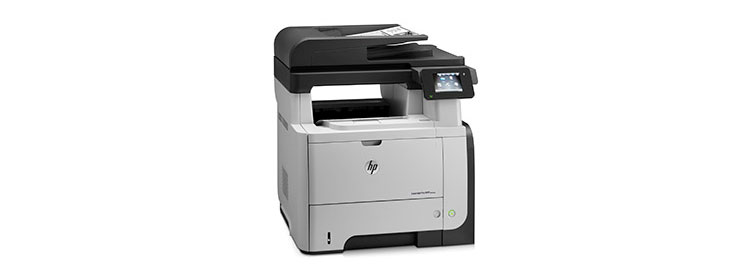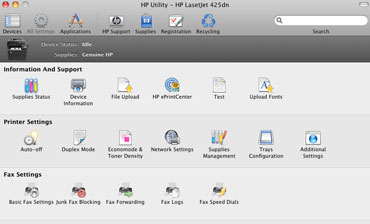The HP LaserJet Pro MFP M521dn ($899.99 direct) is a quietly impressive beast. Designed as a mono laser workhorse, with a 75,000 page per month maximum duty cycle and a 6,000 page per month recommended maximum, it can print and fax from, as well as scan to, a computer, including over a network, and it can work as a standalone copier, fax machine, and direct email sender. More important, it does well enough at everything it does to make it Editors’ Choice for medium to heavy-duty use in a small to mid-size office or workgroup.
There’s nothing flashy here, like super-fast speed. In fact, it’s easy to find printers, like the Editors’ Choice Brother MFC-8950DW$588.96 at pcRUSH.com or the far less expensive Canon imageClass MF4770n$129.99 at OfficeMax that are faster. On the other hand, the M521dn offers a combination of features that make it more usable than most MFPs.
MFP Features and Basics
In addition to the basic MFP features I’ve already mentioned—printing, scanning, copying, faxing, and email—the M521dn can both scan to and print from a USB memory key. In an unusual touch for a monochrome printer, it will even let you preview the photos stored on the memory key before printing them. It also supports printing though the cloud.
Much higher on its list of key features is its scan capability. Like most MFPs aimed at office use, the M521dn supplements a flatbed scanner with an automatic document feeder (ADF). As is common, the flatbed is limited to letter-size paper while the 50-page ADF lets you scan up to legal size. Unlike most of the competition, however, including some significantly more expensive MFPs like the Editors’ Choice Dell B3465dnf Multifunction Laser Printer$1,399.99 at Dell, the M521dn offers a duplex scanner for copying and scanning. (It won’t scan in duplex for faxing, however, which takes a little of the shine off the feature.)
Having a duplex scanner (meaning that it can scan both sides of a page at the same time) is different from having a duplexing ADF, which scans one side, turns the page over, and then scans the other. Either approach will let you scan duplex documents. And if the MFP also offers duplex printing plus appropriate copying commands, as with the M521dn, either approach will also let you copy single- or double-sided originals to your choice of single- or double-sided copies. However, scanning in duplex is a lot faster than scanning with a duplexing ADF.
We don’t usually time duplex scanning with MFPs, because most desktop MFPs that duplex use duplexing ADFs, which is more of a convenience feature than something that’s truly competitive with duplexing scanners. With the M521dn, however, I ran a test using a 25-sheet document just to get a sense of its speed. For scanning to disk, and including the time for saving the file to disk after scanning, the M521dn came in at 10.7 pages per minute (ppm) or 21.4 images per minute (ipm), with one image on each side of the page. If you scan duplex documents very often, this one feature can save a lot of time compared with using an MFP with a duplexing ADF.
Very much on the plus side for the M521dn is the 3.5-inch touch screen, with its particularly well-designed menu system. The combination makes it easy to both change settings in the printer and give commands for copying, faxing, and emailing.
One other strong point is the paper handing for printing, with both a 500-sheet paper drawer and 100-sheet multipurpose tray standard, along with the automatic duplexer. The 600-sheet capacity should be enough for most small to mid-size offices. If you need more, however, you can add a second 500-sheet drawer ($185 street), for a total of 1,100 sheets.
Setup and Speed
At 20.0 by 18.3 by 18.3 inches (HWD), the M521dn is too imposing to share a desk with. It’s also heavy enough, at 52.7 pounds, that you’ll probably want some help moving it. Once in place, however, setup is standard fare. For my tests I connected it to a wired network and installed the driver on a system running Windows Vista.
As I’ve already suggested, speed is not a strong point. HP rates the engine at 42 ppm, and I timed it as being a touch faster, at 43 ppm, for printing a text document with little to no formatting from Microsoft Word. On our business applications suite, however (timed with QualityLogic’s hardware and software), it came in at a surprisingly slow 5.3 ppm. Although that’s a tolerable speed, it’s significantly slower than most other mono laser printers we’ve tested. The Brother MFC-8950DW, for example, managed 10.6 ppm, the Canon imageClass MF4770n came in at 12.3 ppm, and the Dell B3465dnf hit 15.0 ppm
Output Quality and Other Issues
Output quality is a mixed bag. The good news is that the M521dn handled text in our tests particularly well, which is generally the most important kind of output for a mono printer. Text quality was well above par, making it easily good enough for any business use and even good enough for most desktop publishing applications.
Graphics output was a touch below par, but still within the tight range where the vast majority of mono laser MFPs fall. That makes it good enough for any internal business need. Depending on how critical an eye you have, you may or may not consider it acceptable for, say, PowerPoint handouts. Photo quality was also at the low end of par for a mono laser MFP. It was certainly good enough to print recognizable photos from Web pages. Whether you consider it suitable for anything more than that will depend, once again, on how critical an eye you have.
The one feature I wish this printer had that it doesn’t is the ability to fax in duplex. However, if you don’t need to fax duplex documents, that won’t be an issue. It also doesn’t leave you any worse off for faxing than with an MFP that can’t handle duplexing at all, making this oversight more of a missed opportunity than an actual problem.
Faster print speed would be welcome also. However, the time saved with duplex scanning and copying if you need it can more than make up for whatever points the printer loses on print speed. The text quality is a big plus too, as part of a highly attractive balance of speed, output quality, paper handling, and MFP features. For a small to mid-size office that needs to copy or scan (but not fax) duplex documents on a regular basis, all this can make the HP LaserJet Pro MFP M521dn a near-perfect fit, which is also enough to make it an Editors’ Choice.
original article
- HP LaserJet Pro MFP M521dn(pcmag.com)










